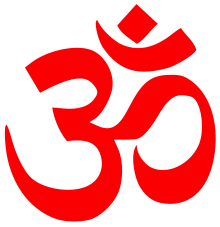ہندو مت کا خاکہ
ہندو ازم کا جائزہ اور ٹاپیکل گائیڈ
مندرجہ ذیل خاکہ میں ہندو مت کو اجمالی طور پر پیش کیا گیا ہے۔ ہندو مت برصغیر کا کثیر آبادی والا مذہب ہے۔[1] ہندو مت کے ماننے والوں کو ہندو کہا جاتا ہے جنہیں سناتن دھرم سے تعبیر کیا جاتا ہے۔[2][3][4]( سناتن دھرم سنسکرت زبان کا لفظ ہے۔ اس کے معنی ’’ابدی دھرم یا قانون‘‘ ہے۔[5][6]) اس کے علاوہ ہندو مت کے کئی دیگر نام ہیں۔[7][8] ہندو مت کا کائی ایک شخص بانی نہیں ہے بلکہ یہ مختلف تیذہبوں اور متنوع روایتوں سے مل کر بنا ہے۔ اس میں کثیر تعداد میں کرم، دھرم اور سماجی خدمت جیسے امور شامل ہیں۔ اس کی جڑیں براہ راست ہندوستان کے آہنی دور کے تاریخی ویدک مذہب سے ملتی ہیں اور اس کی بنیاد کرم، دھرم اور معاشرتی اصول پر ہے۔ ہندو مت کو اکثر دنیا کا قدیم ترین مذہب بھی کہا جاتا ہے۔[9][10][11][12]

ہندو مت کا جوہر
ترمیم تفصیلی مضمون کے لیے ہندو مت ملاحظہ کریں۔
فرقے اور متعلق موضوعات
ترمیمہندو مت کی تاریخ
ترمیمعام ہندو تصورات
ترمیمہندو متون
ترمیمہندو ثقافت
ترمیمعبادت
ترمیممجاہدین آزادی
ترمیمسیاسی رہنما
ترمیمبھکتی
ترمیمدیگر تصورات
ترمیممزید دیکھیے
ترمیمحوالہ جات
ترمیم- ↑ Hinduism is variously defined as a "religion"، "set of religious beliefs and practices"، "religious tradition" etc. For a discussion on the topic, see: "Establishing the boundaries" in Gavin Flood (2003)، pp. 1-17. رینے گینوں in his رینے گینوں (1921 ed.)، Sophia Perennis, آئی ایس بی این 0-900588-74-8، proposes a definition of the term "religion" and a discussion of its relevance (or lack of) to Hindu doctrines (part II, chapter 4, p. 58)۔
- ↑ A Historical-developmental study of classical Indian philosophy of morals، Rajendra Prasad, Centre for Studies in Civilizations (Delhi, India)، Concept Publishing Company, 2009, آئی ایس بی این 81-8069-595-6، آئی ایس بی این 978-81-8069-595-7
- ↑ Hinduism that is Sanatana Dharma آرکائیو شدہ (Date missing) بذریعہ books.google.com (Error: unknown archive URL)، R. S. Nathan, Chinmaya Mission, 1989, آئی ایس بی این 81-7597-065-0، آئی ایس بی این 978-81-7597-065-6
- ↑ A conceptual-analytic study of classical Indian philosophy of morals، Rajendra Prasad, from preface of the book، Centre for Studies in Civilizations (Delhi, India)، Project of History of Indian Science, Philosophy, and Culture. Sub Project: Consciousness, Science, Society, Value, and Yoga, Concept Publishing Company, 2008, آئی ایس بی این 81-8069-544-1، آئی ایس بی این 978-81-8069-544-5
- ↑ Hinduism that is Sanatana Dharma آرکائیو شدہ (Date missing) بذریعہ books.google.com (Error: unknown archive URL)، R. S. Nathan, Chinmaya Mission, 1989, آئی ایس بی این 81-7597-065-0، آئی ایس بی این 978-81-7597-065-6
- ↑ A conceptual-analytic study of classical Indian philosophy of morals، Rajendra Prasad, from preface of the book، Centre for Studies in Civilizations (Delhi, India)، Project of History of Indian Science, Philosophy, and Culture. Sub Project: Consciousness, Science, Society, Value, and Yoga, Concept Publishing Company, 2008, آئی ایس بی این 81-8069-544-1، آئی ایس بی این 978-81-8069-544-5
- ↑ The Concise Oxford Dictionary of World Religions. Ed. John Bowker. Oxford University Press, 2000;
- ↑ The term "Dharma" connotes much more than simply "law"۔ It is not only the doctrine of religious and moral rights, but also the set of religious duties, social order, right conduct and virtuous things and deeds. As such Dharma is the Code of Ethics.[1] The modern use of the term can be traced to late 19th century Hindu reform movements (J. Zavos, Defending Hindu Tradition: Sanatana Dharma as a Symbol of Orthodoxy in Colonial India، Religion (Academic Press)، Volume 31, Number 2, اپریل 2001, pp. 109-123; see also R. D. Baird, "Swami Bhaktivedanta and the Encounter with Religions"، Modern Indian Responses to Religious Pluralism، edited by Harold Coward، State University of New York Press, 1987); less literally also rendered "eternal way" (so Harvey, Andrew (2001)، Teachings of the Hindu Mystics، Boulder: Shambhala، xiii، ISBN 1-57062-449-6)۔ See also رینے گینوں، Introduction to the Study of the Hindu Doctrines (1921 ed.)، Sophia Perennis, آئی ایس بی این 0-900588-74-8، part III, chapter 5 "The Law of Manu"، p. 146. On the meaning of the word "Dharma"، see also رینے گینوں، Studies in Hinduism، Sophia Perennis, آئی ایس بی این 978-0-900588-69-3، chapter 5, p. 45
- ↑ Merriam-Webster's Collegiate Encyclopedia، Merriam-Webster، 2000، صفحہ: 751
- ↑ in the world.Laderman, Gary (2003)، Religion and American Cultures: An Encyclopedia of Traditions, Diversity, and Popular Expressions، Santa Barbara, Calif: ABC-CLIO، صفحہ: 119، ISBN 1-57607-238-X،
world's oldest living civilization and religion
- ↑ Turner, Jeffrey S. (1996)، Encyclopedia of relationships across the lifespan، Westport, Conn: Greenwood Press، صفحہ: 359، ISBN 0-313-29576-X،
It is also recognized as the oldest major religion in the world
- ↑ Klostermaier 1994, p. 1